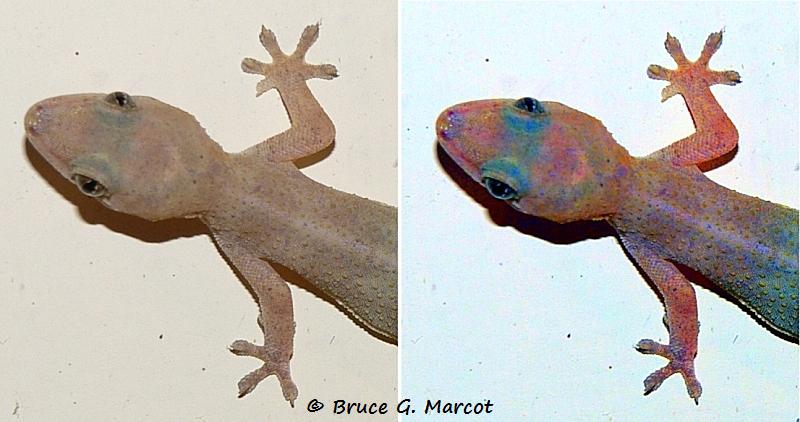
|
|
Hidden Colors of the Gecko |
|
|
Click on images for larger versions
|
Tropical House Gecko (Hemidactylus
mabouia), Family Gekkonidae |
Credit & Copyright: Dr. Bruce G. Marcot
Explanation: Here is a surprising find of a common species. This is the widely-distributed tropical house gecko, found in sub-Saharan Africa, South America, and elsewhere around the globe. They have a wide range of colors, from light tan (shown here) to gray to brown. However, when I over-saturated the colors from my digital photographs, I was surprised to find unexpected patterns of blue and green:
Bands of blue and green appeared across the head between the eyes, and around the mid-body.
Why?
Tropical house geckos are noctural. I took these photos at night with a white flash and no filters. Being nocturnal, these geckos have sharp night vision. I speculate that perhaps they can see some of these colored patterns that might serve as markings for sex or species identification, or perhaps territorial display.
When males engage in territorial bouts, they arch their backs, perhaps revealing additional colors beneath. In courtship behavior, females lift their heads, perhaps also to the same end (Regalado 2003).
Nocturnal geckos, however, tend to communicate by body posture and vocalizations, making this enhanced color pattern puzzling. Perhaps the patterns are merely the result of differences in vascularization and subcutaneous tissue density.
But enhancing colors in other photos I have taken of this species elsewhere also reveals similar patterns, particularly the reddish legs and feet.
I could find no studies of this.
This hungry fellow was well-positioned to enjoy this stream of ants.
Taxonomy of this genus of gecko is confusing,
with species yet to be determined.Tropical house geckos are also a known invasive species
in Florida and elsewhere, and are aggressive predators,
sometimes on other lizards.
Information:
Regalado, R. 2003. Roles of visual, acoustic, and chemical signals in social interactions of the tropical house gecko (Hemidactylus mabouia). Caribbean Journal of Science 39(3):307-320.
Short, K.H., and K. Petren. 2012. Rapid species displacement during the invasion of Florida by the tropical house gecko Hemidactylus mabouia. Biological Invasions 14(6):1177-1186.
Next week's picture:
What To Learn From A Stick
< Previous ... | Archive |
Index |
Location | Search | About EPOW | ... Next >
|
|
Author & Webmaster: Dr.
Bruce G. Marcot
Disclaimers and Legal
Statements
Original material on Ecology Picture of the Week ©
Bruce G. Marcot
Member Theme of The Plexus